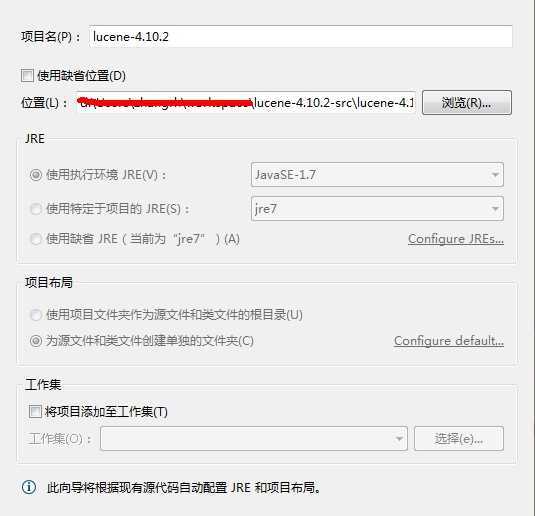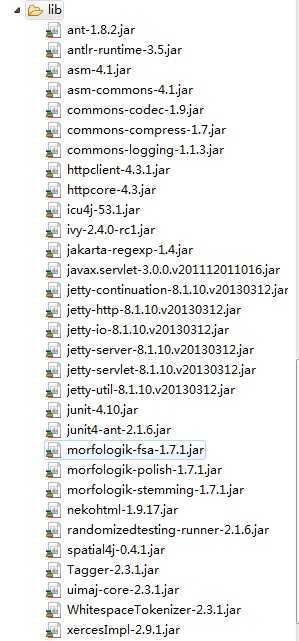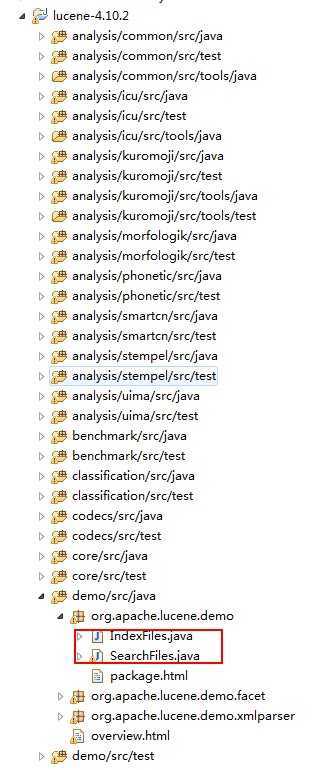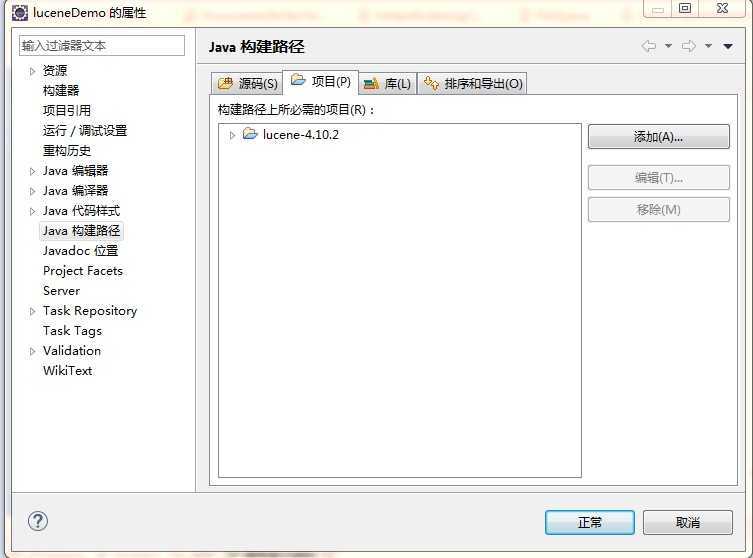标签:Lucene style blog http io ar color os 使用
一直想抽点时间系统的学习下Lucene ,今天把Lucene 源码学习环境搭建了一下。下面描述一下环境搭建过程。
开发环境的配置(lucene-4.10.2 + Eclipse):
1:下载最新源码:把jar包lucene-4.10.2,和java源码lucene-4.10.2-src 都下载下来。
下载地址:http://mirror.bit.edu.cn/apache/lucene/java/4.10.2/
2:在Eclipse 安装lucene-4.10.2 java源码。
新建JAVA 项目,把“使用缺省位置的勾去掉”。选择源码文件目录。

项目加载进来后会有很多错误提示,这是因为还有很多依赖包没有引用到。
解决办法,把jar包lucene-4.10.2 各文件夹下面的lib 文件下面的jar 包都拷贝出来。

在项目中建一个lib 文件夹。把所以的jar 包复制过来。然后,把所以jar 包添加到构建路径。居然有这么多包。

lucene-4.10.2-src\lucene-4.10.2\demo\src\java\org\apache\lucene\demo 这个目录下有两个简单实例,分别是建索引 和 查询 。

新建一个JAVA 项目,并在构建项目中添加lucene-4.10.2的引用。


下面可以自己尝试写demo了。
下面是一个建索引的例子:
package index.demo; import java.io.File; import java.io.IOException; import java.util.*; import org.apache.lucene.analysis.Analyzer; import org.apache.lucene.analysis.standard.StandardAnalyzer; import org.apache.lucene.document.Document; import org.apache.lucene.document.Field; import org.apache.lucene.document.LongField; import org.apache.lucene.document.StringField; import org.apache.lucene.index.IndexWriter; import org.apache.lucene.index.IndexWriterConfig; import org.apache.lucene.index.IndexWriterConfig.OpenMode; import org.apache.lucene.store.Directory; import org.apache.lucene.store.FSDirectory; import org.apache.lucene.util.Version; import index.bean.*; /** * @author zhangrh 索引构建类 */ public class IndexBuilder { private IndexBuilder() { } /** * 索引初始化 */ public static void initIndex() { try { String indexPath = "D://lucene/index"; Directory dir = FSDirectory.open(new File(indexPath)); Analyzer analyzer = new StandardAnalyzer(); IndexWriterConfig iwc = new IndexWriterConfig( Version.LUCENE_4_10_2, analyzer); iwc.setOpenMode(OpenMode.CREATE); IndexWriter writer = new IndexWriter(dir, iwc); ArrayList<Hotel> hotelList = getContentData(); if (hotelList != null) { for (Hotel h : hotelList) { Document doc = new Document(); LongField idField = new LongField("id", h.getId(), Field.Store.YES); doc.add(idField); Field nameCNField = new StringField("name", h.getNameCN(), Field.Store.YES); doc.add(nameCNField); Field nameENField = new StringField("ename", h.getNameEN(), Field.Store.YES); doc.add(nameENField); writer.addDocument(doc); } } writer.close(); } catch (IOException e) { // TODO 自动生成的 catch 块 e.printStackTrace(); } } /** * 返回 {@link Hotel} 内容数据 * * @return An ArrayList of Hotel */ private static ArrayList<Hotel> getContentData() { ArrayList<Hotel> list = new ArrayList<Hotel>(); return list; } }
官方API说明:http://lucene.apache.org/core/4_10_2/index.html
标签:Lucene style blog http io ar color os 使用
原文地址:http://www.cnblogs.com/zrhai/p/4156067.html